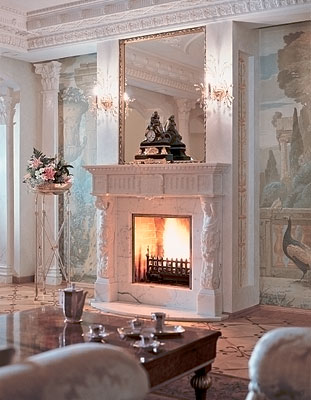The modern market offers us a lot of decorative stucco products, which can be exclusively issued home interior. At the same time, such elements are very affordable, since handmade and expensive building materials are not always used. As for the gypsum analogues made by experienced masters, they are always distinguished by exception, uniqueness, grace and incomparable beauty.
The sculptures of the gypsum not only give the highlight of the room and decorate the facades, but also harmonize the inner space, they develop creative abilities. The technology of their production can occur by pulling through a pattern or using the material casting into the mold, while the parts themselves are not created from the pure powder, but with the addition of various fillers, pigments and resins. In order to strengthen the thin elements, they are reinforced by fiberglass or metal reinforcement. Thus, the more actions occur and the longer it takes work, the more expensive the finished product turns out.
Today we tell about how you can make your own hands, without the involvement of other persons, to make a unique molding product, which will give an impetus to transform the interior of your home.
Content
Decorative column of gypsum
Gypsum columns are impeccable grace and monumental greatness, breathtaking spirit.
They are completely different type:
- with a pattern (chairs) and without it;
- smooth;
- with relief;
- expanding to the bottom, to the top;
- having special thickening (entazis), etc.
The diameter of such a column is usually from 14-35 cm. At the same time, many aesthetes are sometimes skillfully masked under decorative stucco unsuitable pipes and risers.
Composite elements of plaster column:
- the main part is the trunk;
- lower element - base;
- the upper part covered with the ornament - the cap.
The advantages of plaster columns:
- perform a decorative function;
- they can split the living room and the passage of the room;
- some fragments are used as supports;
- such products perfectly look at the staircases, arches and next to the fireplaces.
How to make a gypsum column
The manufacture of gypsum columns, however,, like most of these products, begins with the creation of a template. A concrete, tin, plywood, polyurethane, plastic, metal and gypsum can be used as it.
We will look at the production of a round smooth-bore gypsum column without entazis, since it doesn't need complex machines for its manufacture, half colonents with chaliers, etc.
All activities should occur on a workbench that has a perfectly smooth surface. For such a site, you can apply the windowsill, phaneer with a laminated surface, as well as a marble slab.
We will make a column of two halves, whose seams are close to a solution of plaster, and the body of the product is stretched with a template.
Progress:
- Making a template should be started with a drawing, which is then transferred to tin and the desired profile is cut.
- Cut with special scissors profile is treated with appliances. Please note that in this case it is necessary to be very neat, since any defects can subsequently reflect on the body of the column.
- Metal burgers, which remained after treatment with a supfyl, should polish sandpaper.
- When the profile is ready, it can be transferred to the paneur and cut out the electroll.
- Cut the profile of the substrate from tin, so that the emptiness in the body of the column originates.
- We collect the pattern, not forgetting about the crossbars and the rigid rigging.
- We put the template on the table, fix the plywood support platform and proceed to the production of the substrate.
- It can be pulled out of the gypsum, but only if the radius is from 3-6 cm. If it is more, we recommend using plasterboard.
- Plasterboard with a trapeze and krepim with self-tapping screws.
- We divorce the gypsum material in the bucket, given the parameters of the substrate. At the same time, it should be started exactly so much so that with the subsequent rolling of the second layer, only small depressions remain.
- Pour gypsum into the substrate and roll it with a template. Rolling is performed after each plaster overlay.
- Leave the finished product for a day.
- After the specified time, lubricate the substrate with a shellac or NC lacquer. After drying it, failing the column with oil.
- Remove the substrate profile from the template and proceed to the gallery of the column. To give a greater stiffness, we recommend to apply the fiberglass mesh. Rewinding the column is created in the same way as the revelation of the substrate, namely to a smooth state.
- After 30 minutes, we remove the product from the table and we have it for drying on a flat surface. We are waiting for 2-3 days.
Well-drying gypsum acquires excellent strength and is not damaged when installing. At the same time, if the column was reproached according to the right technology and dried on an ideally flat site, then the installation will be done without difficulty.
In order to decorate the finished product and give it an antique look, you can use the plaster stucco or ornament.
Column with video stucco elements:





























neither the fig is not clear, even with the photo would have done.
Why make a template when you can buy an outdoor pipe sewer and pour
I did it, turned out the column is no worse than polyurethane!